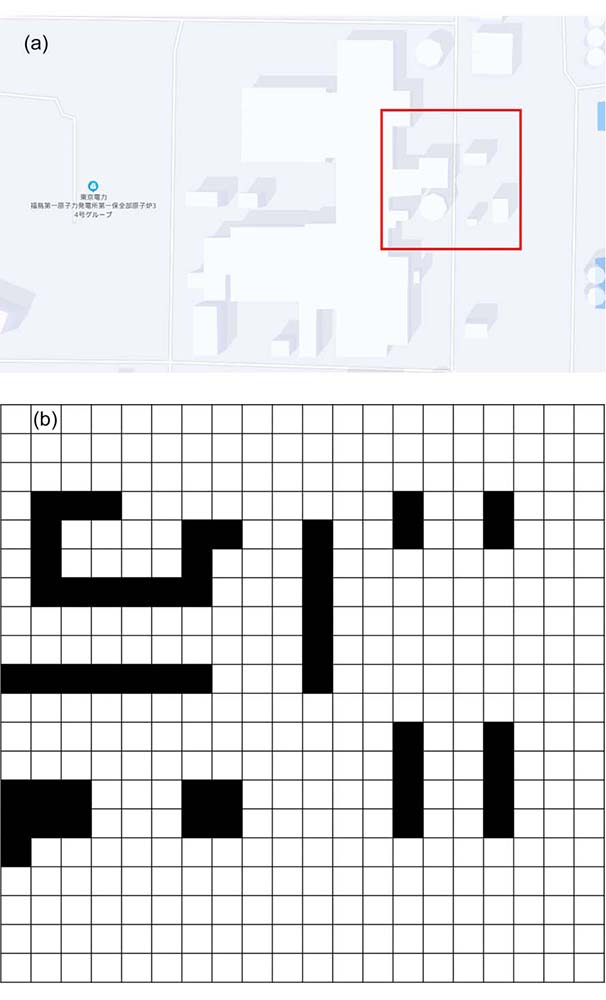辐射研究与辐射工艺学报, 2024, 42 (1): 010601, 网络出版: 2024-03-27
基于生物启发神经网络的核辐射场区全覆盖路径规划
Complete coverage path planning of nuclear radiation field using bio-inspired neural network
生物启发神经网络 核辐射场区 全覆盖路径规划 多单元协同 剂量控制 Bio-inspired neural network Nuclear radiation field Complete coverage path planning Multi-unit collaboration Dose control
摘要
核辐射场区全覆盖路径规划对于辐射环境下区域作业者的辐射安全有重要意义。本研究基于生物启发神经网络算法,提出一种进行辐射剂量最优控制的全覆盖路径规划算法。首先,利用福岛核电站部分地形以及蒙特卡罗粒子输运程序分别构建模拟核辐射场区的障碍物分布和辐射剂量场,然后,采用Python语言进行算法仿真试验,模拟核辐射场区的每一个栅格定义为一个神经元,建立起生物启发神经网络,将栅格剂量率与神经元活性耦合实现路径规划的辐射剂量最优控制,分别采用单个、4个和8个移动单元进行仿真试验。结果表明:单个移动单元的规划路径在实现100%覆盖率,4%覆盖重复率的同时,能够优先覆盖低剂量区,延后覆盖高剂量区,实现了过程剂量和累积剂量的最优控制。为提高全覆盖的时间效率和获得更低的单体累积剂量,对算法进行多单元协同搜索的改进,结果表明:4单元和8单元仿真的覆盖重复率分别为5.72%和6.29%,1单元、4单元和8单元仿真完成全覆盖时间分别为30 min、9 min和4 min,时间效率成倍提高;最大单体累积剂量分别为4.11×10-3 mSv、1.28×10-3 mSv和0.85×10-3 mSv,也在显著降低。本文提出的算法能实现过程剂量和累积剂量最优控制的全覆盖路径规划,另外算法可以协同规划多单元路径,显著降低单体累积剂量,对辐射环境下区域作业的辐射防护有重要意义。
Abstract
Path planning for the complete coverage of nuclear radiation fields is necessary to ensure the radiation safety of regional operators in radiation environments. Based on a bio-inspired neural network algorithm, a complete coverage path-planning algorithm for the optimal control of the radiation dose is proposed. First, part of the terrain of the Fukushima nuclear power plant and the Monte Carlo particle transport program were used to construct the obstacle distribution and radiation dose field in a simulated nuclear radiation field. Subsequently, the Python programming language was used to conduct algorithm simulation experiments. Each grid of the simulated nuclear radiation field was defined as a neuron, and a bio-inspired neural network was established. The grid dose rate and neuronal activity were combined to achieve optimal control of radiation dose in path planning, and single, four, and eight mobile units were used for simulation experiments. The results showed that the planning path of a single mobile unit can achieve 100% coverage and a 4% coverage repetition rate and can first cover the low-dose area and delay the coverage of the high-dose area to achieve optimal control of the process and cumulative doses. The algorithm is improved via a multiunit collaborative search to increase the time efficiency of complete coverage and decrease the cumulative dose of monomers. The coverage repetition rates of four-unit and eight-unit simulations were 5.72% and 6.29%, respectively. The complete coverage times of the one-unit, four-unit, and eight-unit simulations were 30, 9, and 4 min, respectively, and the time efficiency was doubled. The maximum cumulative doses of the monomers for the one-unit, four-unit, and eight-unit simulations were 4.11×10-3, 1.28×10-3, and 0.85×10-3 mSv, respectively, which also decreased significantly. The proposed algorithm can achieve complete coverage path planning of optimal control of the process dose and cumulative dose. Moreover, the algorithm can coordinate multiunit path planning and significantly decrease the cumulative dose of monomers, which is critical for radiation protection during regional operations in a radiation environment.
罗昭锦, 刘程峰, 贾文宝, 单卿, 史潮, 张建东, 黑大千, 张晓军, 凌永生. 基于生物启发神经网络的核辐射场区全覆盖路径规划[J]. 辐射研究与辐射工艺学报, 2024, 42(1): 010601. Zhaojin LUO, Chengfeng LIU, Wenbao JIA, Qing SHAN, Chao SHI, Jiandong ZHANG, Daqian HEI, Xiaojun ZHANG, Yongsheng LING. Complete coverage path planning of nuclear radiation field using bio-inspired neural network[J]. Journal of Radiation Research and Radiation Processing, 2024, 42(1): 010601.




